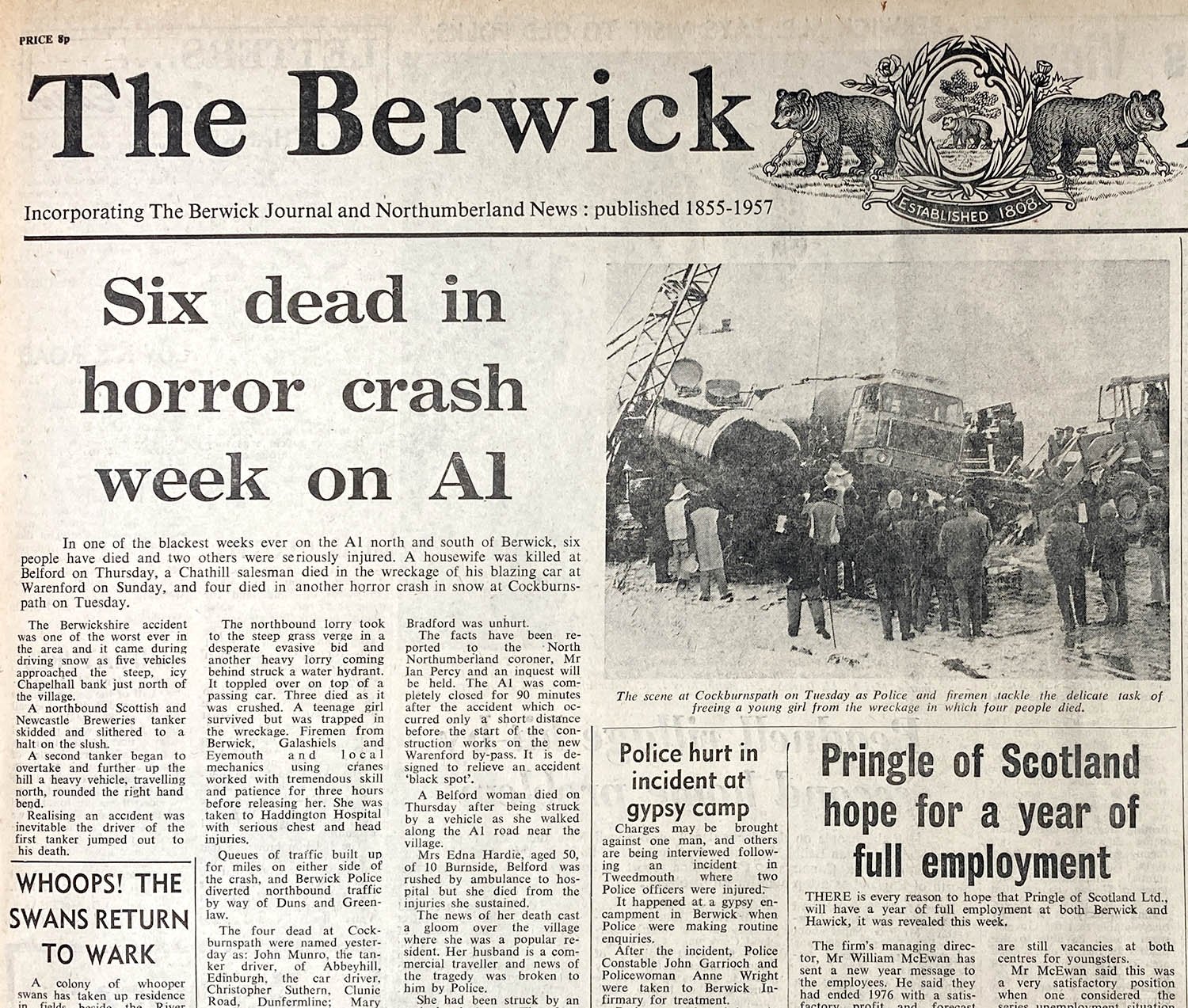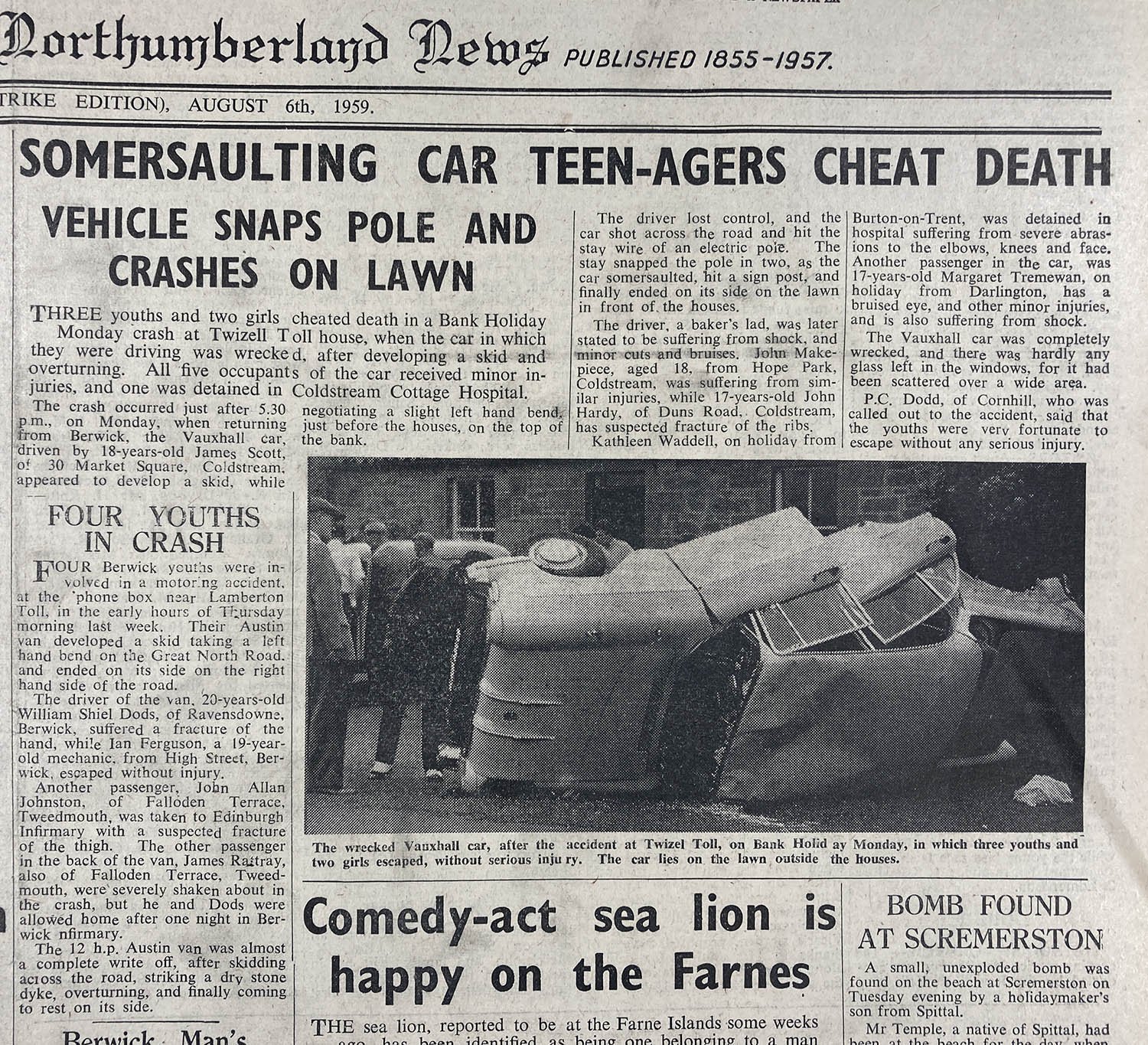CRASH!
A lorry laden with oranges failed to take the corner at the Tweedmouth end of the Royal Tweed Bridge in September 1955. The driver and his Swiss hitchhiking passenger were unharmed. Mr & Mrs Goudie who lived in the cottage were also unharmed as they were asleep in another room.
They were named Berwick’s most unlucky couple - their house was bombed during the war, in 1948 they were flooded out of another house then this! [BRO 1944-1-1005-5]
The photocentre collection really does cover all manner of subjects!
A lot of our collection focusses on jolly events such as weddings, dances, prize givings, plays, parties etc. etc. There is, on the other hand, a darker side to the collection and this post will explore that in a little more detail.
As David Smith’s business became more established during the 1950s, he became the un-official photographer for the local police force. Unlike today, where specially trained officers document every detail of a crime scene or accident site, the police didn’t have their own photographer at this time.
Police investigate an accident on the A1, April 1961. [BRO 1944-1-3150-8]
From his many years in journalism, David Smith would have been used to being called out of bed in the middle of the night to report on an unfolding news story. This training will have come in very handy when he received a phone call from the police at 3am asking him to photograph the scene of a road accident.
^ This set of images show the miraculous escape of Mr Walter Richardson. His car left the road and went over the edge of the Brae at Burnmouth. Luckily the wheels caught in the fencing wire. He was trapped upside down in the car until a group of fishermen secured the car with further ropes and rescued him!
As you can well imagine, many of the scenes which greeted the photographers over the years would have been gruesome – this is of course very much part of the training received by police photographers today. It would appear from newspaper coverage at the time that the roads around Berwick were a blackspot for road accidents. Add to the dangerous roads the fact that seatbelts didn’t become compulsory in the UK until 1983 and that air bags and crumple zones were but a twinkle in a designer’s eye, you had the perfect storm.
A witness, Mr Sweryda, inspects the wreckage of a van at West Newbiggin, nr, Norham. Mr Duffy had approached a level crossing and failed to see the oncoming train. The van was dragged along by the engine and he was thrown from the van. Duffy survived the accident having been taken to Berwick Infirmary onboard the train which had hit him. [BRO 1944-1-1787-2]
During the 1960s, local newspapers would often run reports of several accidents each week, more often than not, at least one was fatal. It seemed to be the case that the more horrific the accident was, the bigger the photograph on page one!
On arriving at the scene, the initial photographs taken by Smith were handed over to the police. These would have recorded the scene in detail for the investigation, including any fatalities.
Ian Smith interviews a witness to an accident at Goswick, December 1969. [BRO 1944-1-5406-53]
In journalistic terms, there was a silver lining to attending these often grizzly scenes. It put David and Ian Smith and their photographers first on the scene to take photographs and get a report for the press. Although it would be almost unthinkable now for an editor of a local paper to run graphic photographs of a car accident, there was quite an appetite for this type of material well into the 1970s.
From around 1953 onwards, the Photo Centre index is filled with crash scenes, catalogued simply under ‘Accidents’. Even the description lines are quite matter of fact. ‘Car and lorry at Ayton, Honeymoon Couple’, ‘Tractor Tragedy’ and ‘Double fatality at Alnwick’ to name but three. Other lines merely give the location of the accident. Looking at these negatives which show mangles masses of steel, you have to wonder how anyone walked away from any these accidents alive!
A policeman inspects the wreckage of a lorry which left the road and crashed over Twizell Bridge, December 1959. [BRO 1944-1-2622-7]
As well as general photographs of the scene and the vehicles involved, the photographer would also try to get a photograph of the driver and passengers if they were not too seriously hurt. Often they are posing next to their vehicle or in some cases they’re photographed in a nearby house where they’ve taken refuge awaiting a doctor.
^ A lorry which ran out of control and crashed over a 200ft embankment at Partinhall, Burnmouth. The lorry somersaulted twice on the way down. Miraculously, the 18 year old driver and two passengers survived.
I have always found this set of photographs fascinating. A few years ago, I came across the work of the Swiss police photographer Arnold Odermatt. He spent his career photographing scenes such as these. The images in his book ‘Karambolage’ (or ‘Pileup’ in English) show that time can transform these images from simply being documents of a horrific moment in someone’s life. Each image is simply titled with a location and a date. This leaves you wondering what the story was behind the image. The closeup shots of melted tail lights and dinted metal are almost artistic.
An Austin is photographed in a barn close to where it crashed near Norham. Sometimes photographs were taken for insurance purposes or at the request of the court rather than for the press. [BRO 1944-1-758-4]
Where the Photo Centre index description of a crash scene simply gives a place, this places a barrier between you and the image. You can’t say for certain what the outcome was and your mind creates its own story. This sense of mystery echos the morbid curiosity which exists generally around car accidents. When driving down the motorway, it’s almost impossible not to look when passing an accident scene on the road.
An excerpt from the Photo Centre’s hand written index. ‘Accidents - 1951-1958’
These photographs, when viewed in the surroundings of the archive form tell us a multitude of stories. We can see how the popularity of the car rose drastically in the 1960s, we can build a map of accident blackspots in the area, we can see who even elementary safety features introduced over time may have saved more lives. At a basic level we can simply see what types of vehicles were on the road at the time.
21 Year old Derek Parker of Edinburgh, the driver of a fruit lorry, poses by the wreckage of his vehicle (smoking!) by the A1. He had been travelling north from Newcastle when he crashed through a hedge and overturned the lorry. [BRO 1944-1-462-8]
At a local level, these photographs will always be a document relating to the loss of a loved one and this must never be underestimated. Through the presentation of similar images in Odermatt’s book we see that these images, when edited and captioned in the correct way, can have another life and can be viewed in another way.
The Photo Centre’s own van at Ancroft, December 1978. [BRO 1944-1-6932-200]
Note: As far as my research suggests, none of the photographs presented in this article show accidents which resulted in any fatalities.
















